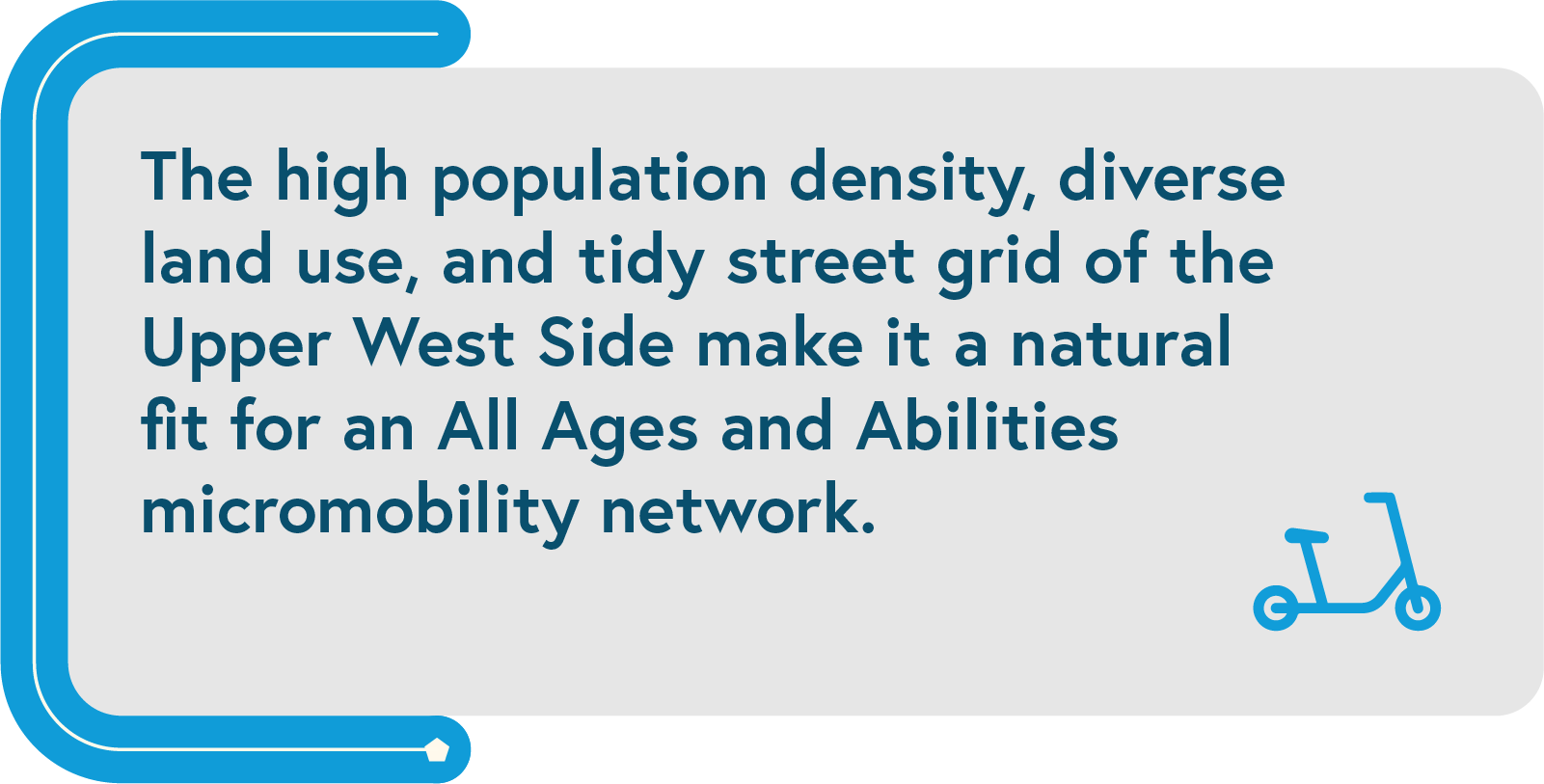A Neighborhood Perfectly Suited to Micromobility
The high population density, diverse land use, and tidy street grid of the Upper West Side make it a natural fit for an All Ages and Abilities micromobility network [1.1]. Gorgeous residential blocks. Iconic parks. Lively commercial corridors. Cultural institutions. More than sixty schools. All in an area just under two square miles. You can ride a bike north to south across the Upper West Side in about fifteen minutes, and across town, from Central Park to Riverside Park, in less than ten.
So what’s holding the Upper West Side back from being a micromobility mecca? Why aren’t we there yet?
A century of shaping streets and public space around the movement and storage of automobiles has marginalized getting around by human-scaled modes of transportation. Journeys on foot or by bike are frequently unpleasant and, too often, downright dangerous.
As the benefits of micromobility use are realized, and more people take up these devices to meet their transportation needs, more space is required [1.2]. But reclaiming space in the public right-of-way for people over cars inevitably meets the headwinds of social and political inertia.
Change is hard. But it’s also inevitable. To meet the micromobility moment and create streets that are safe, sustainable, and accessible to everyone, we need progress to happen much more quickly than it has over the past twenty years.
UWS Micromobility Infrastructure Over Time
The first nineteen blocks (just under one mile) of protected bike lane on the Upper West Side were installed on Columbus Avenue in 2010. Since then, an additional six miles of protected bike lane have been installed, spanning the lengths (with some notable gaps) of Columbus Avenue, Amsterdam Avenue, and most recently, Central Park West.
At the current rate, it would take another half century to build out a protected network on every street on the Upper West Side [1.3]. But as we’ll see in our field survey and recommendations, it's quality, as much as quantity, that really matters with micromobility infrastructure. There are ways to achieve safe and accessible networks that don’t rely exclusively on expensive, long-term capital projects. The time to act is now.
Growing Ridership
by the Numbers
Citi Bike Data
Now ten years old, Citi Bike has been an unqualified success and has supercharged the inevitable shift toward adoption of micromobility in New York City. In 2022, Citi Bike saw its highest ridership citywide, with 29.5 million trips, and ridership has continued to increase through the first three months of 2023 [1.4]. More than 2.4 million of those trips started or ended on the Upper West Side, which is more than 6,500 per day, and 54% greater ridership per square mile than the city average [1.5]. The forty-six UWS stations saw an average 68,000 trips each, and 48% of all trip start/end points—over 1.5 million trips in total— were at stations on streets that do not currently have protected micromobility infrastructure.
DOT Bike Counts
Every single day, New Yorkers make more than a half million bicycle trips throughout the five boroughs; tens of thousands of those are on the Upper West Side.
From 2018, the most recent pre-pandemic data available, to 2022, ridership increased 148% on the Upper West Side's three protected bike routes. On Central Park West, which saw the completion of a protected northbound bike lane over this time period, ridership increased 169%. [1.6]
(The NYC Department of Transportation only counts bicycle trips on the avenues of the Upper West Side; no reliable data is available for cross streets.)
Since 2010, when the Upper West Side’s first protected bike lane went in [1.7], bicycle ridership in the city has more than doubled [1.8]. Ridership along the Upper West Side’s three protected bike lanes increased by 249% between 2015–2022. Amsterdam Avenue saw the greatest increase over this period at 308%. [1.9]
However you slice it, more and more people are using micromobility, and infrastructure needs to keep up.


